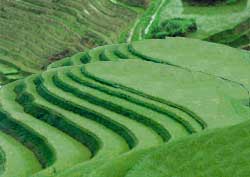Long Ji Rice Terraces
 Why
Long Ji Rice Terraces
are special
Why
Long Ji Rice Terraces
are specialLong Ji is one of the world's most beautiful rice terraces. It is also one of the world's largest rice terraces, measuring 66 square kilometers (26 square miles).
Long Ji rice terraces tips and insights
How to pronounce
Long Ji: lah'ng gee
Creation
The Long Ji Rice terraces were begun in earnest during the Yuan Dynasty (1271-1368) and were virtually completed by 1700.
Name
The term Long Ji translates as Dragon's Back, the popular English name for the terraces.
When to visit
The time you go will affect what you see. The paddies are lush green with growing rice stalks in the summer. After the fall harvest, paddies are exposed bare soil (no greenery or water). They are later filled with water, forming reflecting pools. They remain that way until the first rice shoots appear in the spring.
Configurations
Most terraces are carved out of the hillside, one directly above the other. Some terraces spiral upwards, forming one continuous path around a hill, from its base to its top (this facilitates irrigation by allowing the water to flow down an unbroken track).
Slope angles
The slopes are steep (30 degree average). Some have 50 degree inclines.
Altitude
The highest Long Ji terraces are 1100 meters (3600 feet) above sea level.
Getting there
To reach the Long Ji terraces from Guilin (the major tourism city of the Guangxi autonomous region), you drive three hours north to the regional city of Longsheng, then one hour southeast up a twisting mountain road to Long Ji.
Nearby villages
Explore some of the interesting ethnic villages in the region around Long Ji, including those of the Shuang and Yao people.


